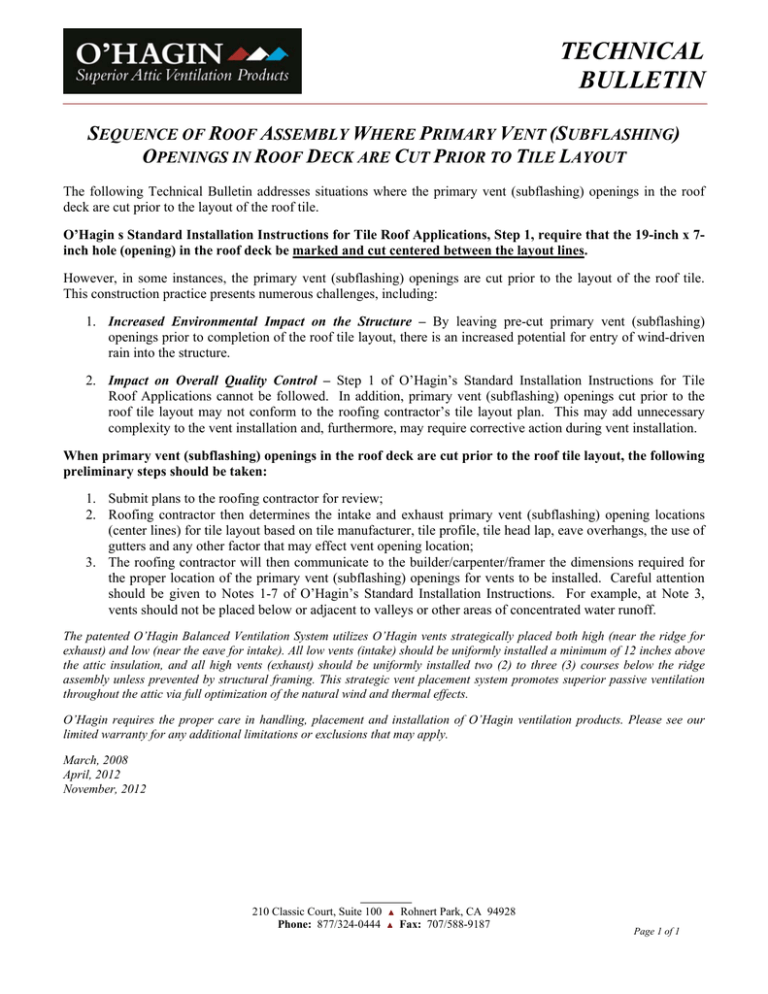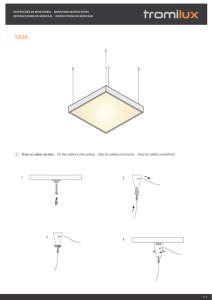technical bulletin
Anuncio

TECHNICAL BULLETIN SEQUENCE OF ROOF ASSEMBLY WHERE PRIMARY VENT (SUBFLASHING) OPENINGS IN ROOF DECK ARE CUT PRIOR TO TILE LAYOUT The following Technical Bulletin addresses situations where the primary vent (subflashing) openings in the roof deck are cut prior to the layout of the roof tile. O’Hagin s Standard Installation Instructions for Tile Roof Applications, Step 1, require that the 19-inch x 7inch hole (opening) in the roof deck be marked and cut centered between the layout lines. However, in some instances, the primary vent (subflashing) openings are cut prior to the layout of the roof tile. This construction practice presents numerous challenges, including: 1. Increased Environmental Impact on the Structure – By leaving pre-cut primary vent (subflashing) openings prior to completion of the roof tile layout, there is an increased potential for entry of wind-driven rain into the structure. 2. Impact on Overall Quality Control – Step 1 of O’Hagin’s Standard Installation Instructions for Tile Roof Applications cannot be followed. In addition, primary vent (subflashing) openings cut prior to the roof tile layout may not conform to the roofing contractor’s tile layout plan. This may add unnecessary complexity to the vent installation and, furthermore, may require corrective action during vent installation. When primary vent (subflashing) openings in the roof deck are cut prior to the roof tile layout, the following preliminary steps should be taken: 1. Submit plans to the roofing contractor for review; 2. Roofing contractor then determines the intake and exhaust primary vent (subflashing) opening locations (center lines) for tile layout based on tile manufacturer, tile profile, tile head lap, eave overhangs, the use of gutters and any other factor that may effect vent opening location; 3. The roofing contractor will then communicate to the builder/carpenter/framer the dimensions required for the proper location of the primary vent (subflashing) openings for vents to be installed. Careful attention should be given to Notes 1-7 of O’Hagin’s Standard Installation Instructions. For example, at Note 3, vents should not be placed below or adjacent to valleys or other areas of concentrated water runoff. The patented O’Hagin Balanced Ventilation System utilizes O’Hagin vents strategically placed both high (near the ridge for exhaust) and low (near the eave for intake). All low vents (intake) should be uniformly installed a minimum of 12 inches above the attic insulation, and all high vents (exhaust) should be uniformly installed two (2) to three (3) courses below the ridge assembly unless prevented by structural framing. This strategic vent placement system promotes superior passive ventilation throughout the attic via full optimization of the natural wind and thermal effects. O’Hagin requires the proper care in handling, placement and installation of O’Hagin ventilation products. Please see our limited warranty for any additional limitations or exclusions that may apply. March, 2008 April, 2012 November, 2012 210 Classic Court, Suite 100 Phone: 877/324-0444 ▲ ▲ Rohnert Park, CA 94928 Fax: 707/588-9187 Page 1 of 1 BOLETÍN TÉCNICO SECUENCIA DE ASAMBLEA DE TECHO DONDE LAS ABERTURAS EN LA SUPERFICIE DEL TECHO PARA LA VENTILA PRIMARIA SERÁN CORTADAS PREVIO AL DISEÑO DE LA TEJA DEL TECHO El siguiente Boletín Técnico se dirige a situaciones donde las aberturas en la superficie del techo para la ventila primaria sean cortadas previo al diseño de la teja del techo. Las Instrucciones de Instalación Estándar para las Ventilas de Concreto y Barro O’Hagin’s Paso 1, requiere que la abertura de 19-pulgadas x 7-pulgadas en la superficie del techo sea marcada y cortada centrada entre las líneas guías. Sin embargo, en algunos instantes las aberturas para la ventila primaria son cortadas previo al diseño de la teja del techo. Esta práctica de construcción presenta numerosos retos, incluyendo: 1. El Aumento de Impacto Medioambiental en la Estructura. Al dejar aberturas precortadas para ventilas primarias previo a la terminación del diseño de taja del techo, hay un aumento de potencial de que la lluvia que es esforzada por el viento entre a la estructura. 2. Impacto en Control de Calidad Total. El Paso 1 de las Instrucciones de Instalación Estándar para Ventilas de O’Hagin’s no pueden ser seguida. Además, las aberturas para las ventilas primarias cortadas previo al diseño de la teja del techo tal vez no ajustarán al diseño de teja del techo del contratista de techo. Esto puede aumentar complejidad innecesaria a la instalación de ventilas, y además, pueda requerir acción correctiva durante la instalación de ventilas. Cuando aberturas en la superficie del techo para la ventila primaria sean cortadas previo al diseño de teja del techo, los siguientes pasos preliminares deben de ser tomados: 1. Someta planos al contratista de techo para revisar; 2. El contratista de techo entonces determinara las ubicaciones de las aberturas para las entradas y salidas de aire de la ventila primaria para el diseño de teja del techo basado al fabricante de teja, el perfil de la teja, alero sobresaliente, el uso de canaletas y cualquier otro factor que pueda afectar la ubicación de aberturas de ventilas; 3. El contratista de techo entonces comunicara al constructor/carpintero/enmarcador las dimensiones necesarias para la ubicación apropiada para las ventilas que serán instaladas. Debe de prestar atención cuidadosa a las Notas 1-7 de las Instrucciones de Instalación Estándar O’Hagin’s. Por ejemplo, en la Nota 3, ventilas no deben ser colocadas debajo o al lado de los valles o a otras áreas de la salida concentrada de agua. El Sistema Balanceado de Ventilación patente de O’Hagin utiliza ventilas O’Hagin colocadas estratégicamente ambos altas (cerca de la cresta para la entrada de aire) y bajas (cerca del alero para la salida de aire). Todas las ventilas bajas (entradas de aire) deben ser instaladas de manera uniforme lo mínimo de 12-pulgadas sobre el aislamiento del desván y todas las ventilas altas (salida de aire) deben ser instaladas de manera uniforme dos (2) a tres (3) hileras de losetas debajo de la cresta superior del tejado, a menos que no lo permita la estructura. El sistema de colocación de ventila estratégico promueve ventilación pasiva superior por todo el desván vía completa optimización del viento natural y efectos termales. O’Hagin requiere el cuidado apropiado en el manejo, colocación e instalación de productos de ventilación O’Hagin. Por favor vea nuestra garantía limitada para cualquier limitación o exclusión adicional que pueda aplicar. March, 2008 April, 2012 November, 2012 210 Classic Court, Suite 100 Phone: 877/324-0444 ▲ ▲ Rohnert Park, CA 94928 Fax: 707/588-9187 Page 1 of 1






